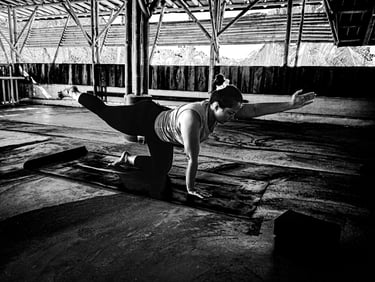What is Hatha Yoga?
Yogic breathing techniques, for instance, help regulate stress responses and support digestion—a key function of apāna.
Through postures (āsana), breath control (prāṇāyāma), cleansing techniques (kriyā), and subtle practices like bandha and mudrā, Hatha Yoga prepares the body and mind for deeper states of meditation. These tools are not ends in themselves, but gateways to inner stillness, clarity, and integration.
Breath As The Guide
In our practice, movement unfolds in time with breath—neither fast nor slow, but attuned to our individual rhythm. We inhale to rise, to open; we exhale to root, to release. This synchrony creates a gentle momentum that supports both physical stability and mental ease.
From a physiological perspective, this can be seen as balancing the sympathetic (prāṇic, activating) and parasympathetic (apānic, relaxing) branches of the nervous system.
Hatha Yoga is one of the classical paths of yoga, rooted in the wisdom of balancing opposites within the human system. The word Haṭha symbolises the union of ha (sun, symbolising prāṇa – the upward-moving life force) and ṭha (moon, symbolising apāna – the downward-moving, grounding energy). It is this energetic balance—not simply the performance of poses—that lies at the heart of the practice.
Effort Without Force
In Hatha Yoga, faster is not better. It is a path of steady, patient effort (abhyāsa), not force. Progress is not measured by intensity, but by sensitivity—how deeply we can listen, feel, and respond from within.
Because Hatha Yoga works on the body’s subtle energy systems, it must be approached with care. When powerful techniques are practised without proper preparation or grounding, they can lead to imbalances—restlessness, fatigue, or emotional overwhelm.




More Insights
